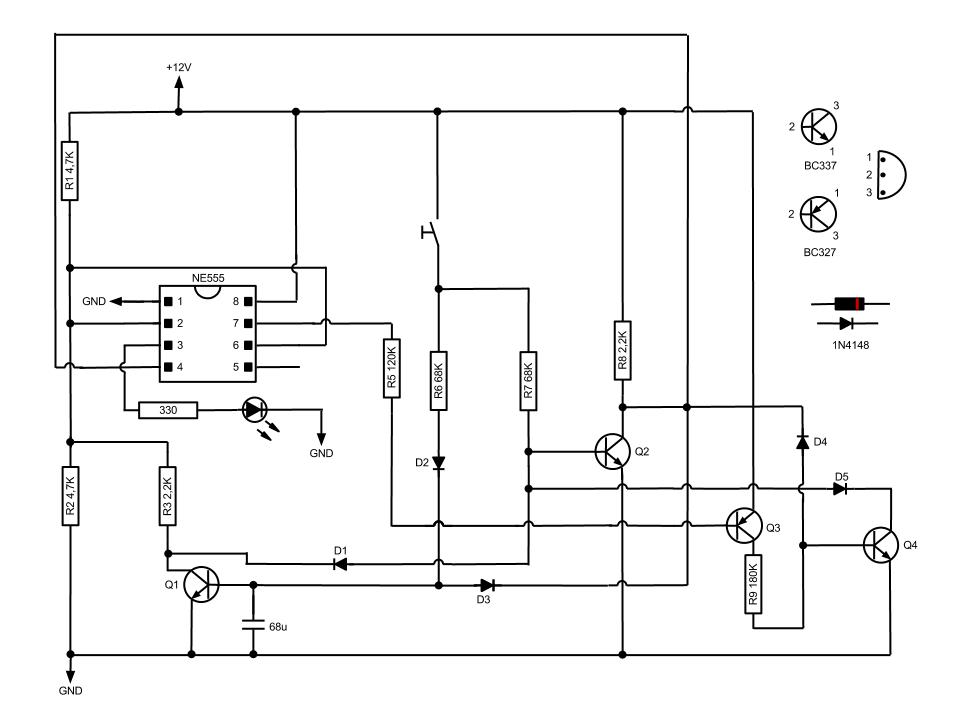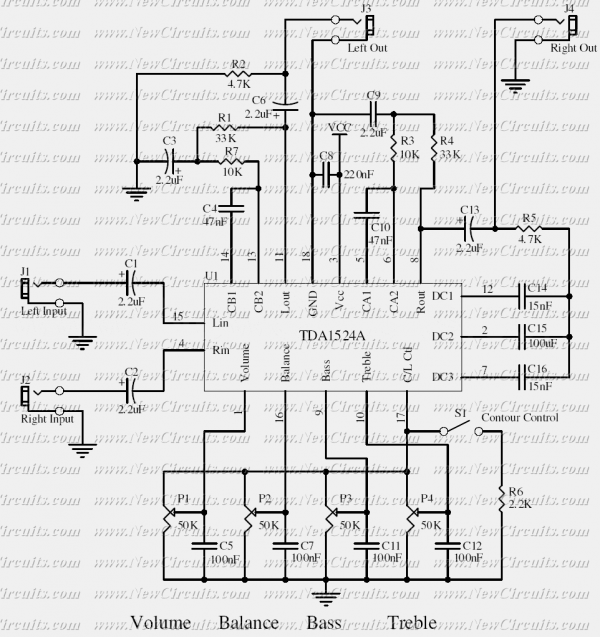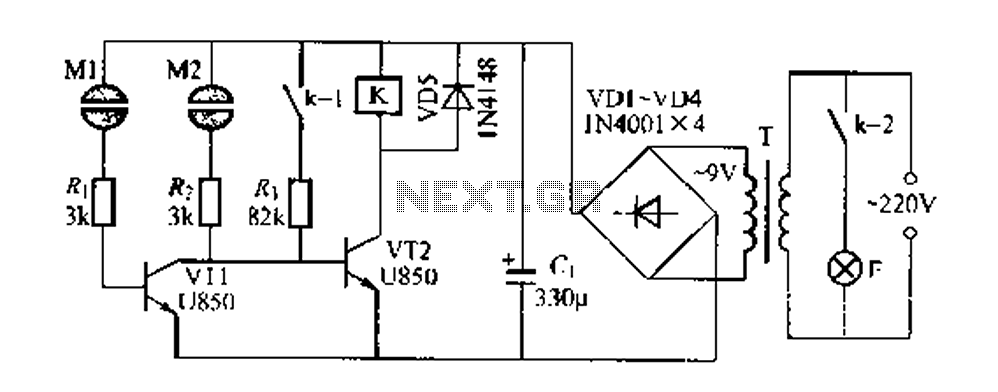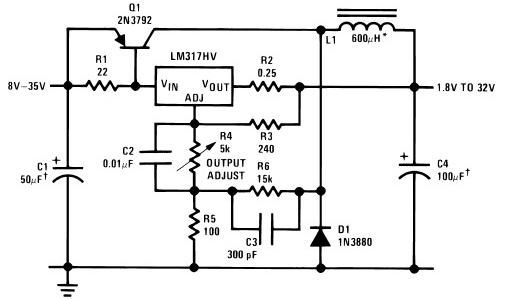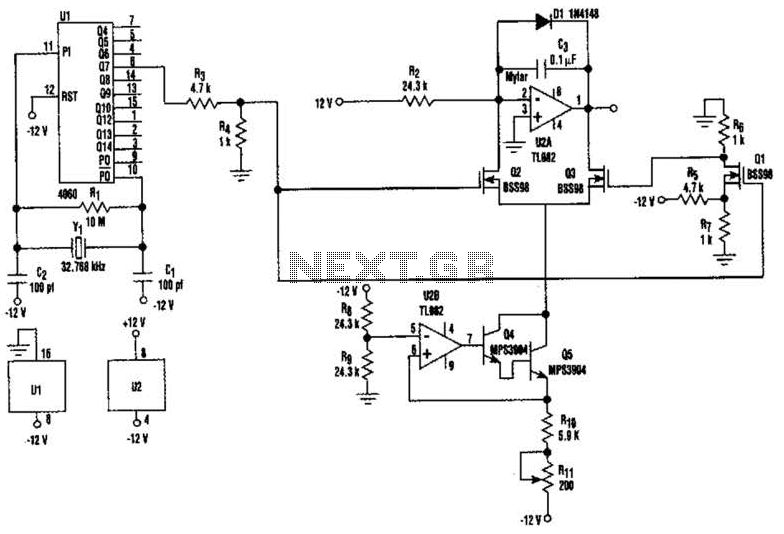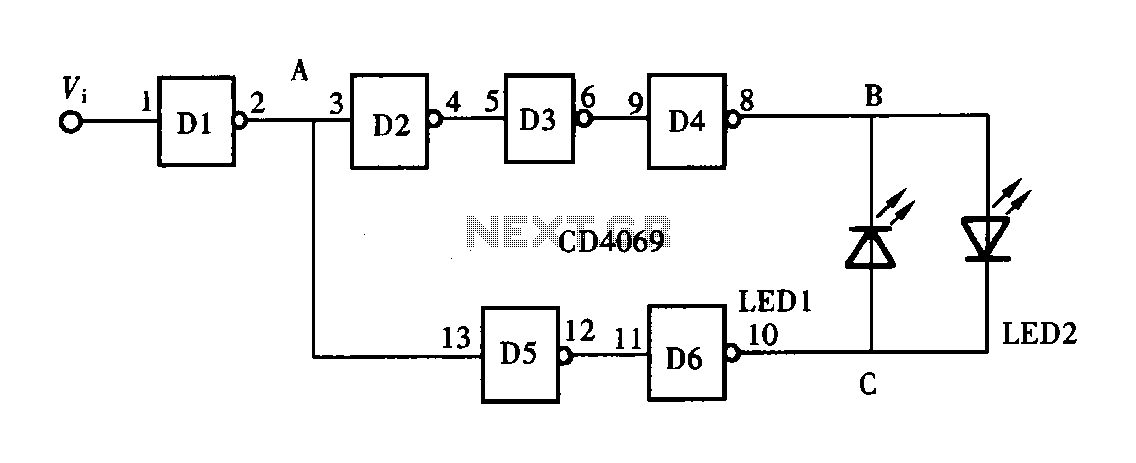
Attenuation feedback tone circuit
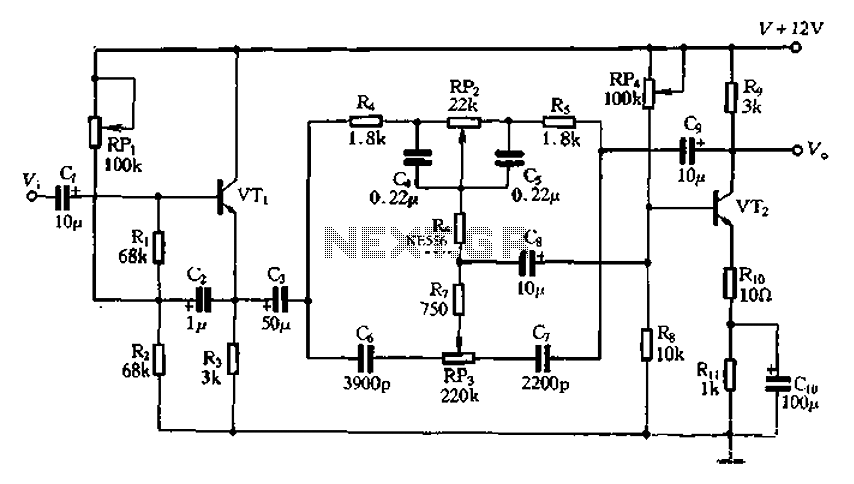
The attenuation circuit is a feedback tone control system that consists of transistors and an RC network. The circuit includes a low tone control potentiometer (RP2) and a treble control potentiometer (RP3). The bass control is influenced by resistor R5, while treble adjustment is managed through a negative feedback mechanism involving resistors R4 and R6, which collectively enhance the high frequencies. As the slider of potentiometer RP2 moves from left to right, the bass is gradually reduced due to an increase in impedance, while negative feedback progressively enhances the bass response. When the slider reaches the extreme right position, maximum attenuation of low tones is achieved, maintaining the original treble level and ensuring a constant feedback amount, resulting in the greatest bass attenuation. Similarly, as the slider of potentiometer RP3 is moved from left to right, the treble is attenuated, with resistance increasing over time, influenced by the negative feedback loop. When RP3 is fully to the right, maximum treble attenuation is reached, complemented by the deepest level of negative feedback. The circuit features a control range of 20 dB for bass at 30 Hz and 15 dB for treble at 10 kHz, exhibiting low distortion, although the control characteristics are significantly influenced by the gain of transistor VT2.
The attenuation feedback tone control circuit operates by utilizing transistors and resistive-capacitive (RC) networks to manipulate audio signals. The circuit's design allows for independent adjustment of bass and treble frequencies, providing users with the flexibility to tailor sound output to their preferences. The low tone control potentiometer (RP2) enables gradual attenuation of bass frequencies. As the user adjusts the slider from left to right, the impedance increases, leading to a decrease in bass output. This adjustment is complemented by the negative feedback loop that enhances the bass response, ensuring that the audio remains rich and full even as lower frequencies are attenuated.
The treble control potentiometer (RP3) functions similarly, allowing for fine-tuning of high-frequency sounds. As the slider is moved, the resistance increases, which in turn affects the negative feedback mechanism, resulting in a gradual reduction of treble frequencies. This design feature ensures that the overall tonal balance of the audio output can be maintained, even as specific frequency ranges are adjusted.
The circuit's performance is characterized by a control range of 20 dB for bass at 30 Hz and 15 dB for treble at 10 kHz, which indicates its capability to significantly alter the audio signal while maintaining low distortion levels. However, it is essential to note that the control characteristics are heavily influenced by the gain of transistor VT2, which plays a critical role in determining the overall response of the circuit. Proper selection and biasing of this transistor are crucial for optimal performance, ensuring that the tone control circuit functions effectively across various audio applications. Attenuation is a feedback tone control circuit consists of transistors and RC network formed. Circuit, RPz low tone control potentiometer, RP3 treble control potentiometer o Wh en RPz, slip point RP3 are located on the left, the bass by R, once attenuated by R5 treble by a tributary of the negative feedback attenuation while at the same time by the tenor R4, R6 and two negative feedback attenuation, to form a high, bass boost. When the sliding point RP2 gradually moves from left to right, the bass is cut by a further gradual increase Torr impedance attenuation, bass while negative feedback will gradually play a role and a step by step increase.
When the slide is moved to the right point RPz, low tone by the maximum attenuation and feedback to achieve the deepest, while the treble is still maintained the original amount and the amount of feedback attenuation constant, which formed the largest bass attenuation. When Wei, sliding point gradually moves from left to right, the treble is attenuated RP3 resistance gradually increases with time and by the negative feedback branch of the island gradually increasing.
When the RP3 to the extreme right, the treble most attenuated, and the negative feedback to achieve the deepest, which formed the maximum attenuation treble. Circuit characteristics: Control Range Bass 30 time is 20dB; 10kHz treble control range is 15dBo when the big circuit control range, low distortion, but the control characteristics greatly influenced by VT2 magnification.
The attenuation feedback tone control circuit operates by utilizing transistors and resistive-capacitive (RC) networks to manipulate audio signals. The circuit's design allows for independent adjustment of bass and treble frequencies, providing users with the flexibility to tailor sound output to their preferences. The low tone control potentiometer (RP2) enables gradual attenuation of bass frequencies. As the user adjusts the slider from left to right, the impedance increases, leading to a decrease in bass output. This adjustment is complemented by the negative feedback loop that enhances the bass response, ensuring that the audio remains rich and full even as lower frequencies are attenuated.
The treble control potentiometer (RP3) functions similarly, allowing for fine-tuning of high-frequency sounds. As the slider is moved, the resistance increases, which in turn affects the negative feedback mechanism, resulting in a gradual reduction of treble frequencies. This design feature ensures that the overall tonal balance of the audio output can be maintained, even as specific frequency ranges are adjusted.
The circuit's performance is characterized by a control range of 20 dB for bass at 30 Hz and 15 dB for treble at 10 kHz, which indicates its capability to significantly alter the audio signal while maintaining low distortion levels. However, it is essential to note that the control characteristics are heavily influenced by the gain of transistor VT2, which plays a critical role in determining the overall response of the circuit. Proper selection and biasing of this transistor are crucial for optimal performance, ensuring that the tone control circuit functions effectively across various audio applications. Attenuation is a feedback tone control circuit consists of transistors and RC network formed. Circuit, RPz low tone control potentiometer, RP3 treble control potentiometer o Wh en RPz, slip point RP3 are located on the left, the bass by R, once attenuated by R5 treble by a tributary of the negative feedback attenuation while at the same time by the tenor R4, R6 and two negative feedback attenuation, to form a high, bass boost. When the sliding point RP2 gradually moves from left to right, the bass is cut by a further gradual increase Torr impedance attenuation, bass while negative feedback will gradually play a role and a step by step increase.
When the slide is moved to the right point RPz, low tone by the maximum attenuation and feedback to achieve the deepest, while the treble is still maintained the original amount and the amount of feedback attenuation constant, which formed the largest bass attenuation. When Wei, sliding point gradually moves from left to right, the treble is attenuated RP3 resistance gradually increases with time and by the negative feedback branch of the island gradually increasing.
When the RP3 to the extreme right, the treble most attenuated, and the negative feedback to achieve the deepest, which formed the maximum attenuation treble. Circuit characteristics: Control Range Bass 30 time is 20dB; 10kHz treble control range is 15dBo when the big circuit control range, low distortion, but the control characteristics greatly influenced by VT2 magnification.
